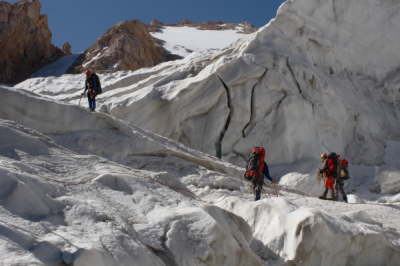
Altitude sickness is a serious danger for those traveling to high altitudes. Being prepared and knowing the facts about altitude sickness can help keep you safe.
With trekking season in full swing, Global Rescue members heading to the peaks should be prepared with the facts about altitude sickness. Global Rescue medical advisor Dr. Eric Johnson, a globally recognized expert on high-altitude medicine who has spent decades practicing high altitude medicine, answers some of the most frequently asked questions about the types of altitude sickness, their symptoms and treatment.
What is altitude sickness?
Traveling to altitudes higher than 8,000 feet can sometimes cause health problems. This group of problems is called “altitude sickness” and there are three main types. The symptoms differ depending on the type of altitude sickness you have.
Acute mountain sickness (AMS)
This is the most common type and causes symptoms similar to those caused by an alcohol hangover, usually within a day or so of arriving at altitude. Acute mountain sickness can happen within a day of traveling or climbing to a very high altitude (above 8,000 feet). The symptoms can include:
- Headache
- Feeling tired
- Feeling lightheaded
- Having no appetite
- Trouble sleeping
- Nausea, sometimes with vomiting
High altitude cerebral edema (HACE)
This is less common but more serious than acute mountain sickness. It involves swelling of the brain and usually involves symptoms of AMS but with worsened brain symptoms (commonly an inability to walk in a coordinated fashion).
The symptoms of HACE usually start one to three days at a high altitude. They include:
- Extreme tiredness and weakness
- Trouble walking normally
- Confusion and irritability
- Acting drunk
High altitude pulmonary edema (HAPE)
This is also less common and more serious than acute mountain sickness. It involves fluid build-up in the lungs.
The symptoms of HAPE usually start two to four days after traveling or climbing to a high altitude. They include:
- Coughing
- Feeling breathless, with worsening exercise tolerance
- Trouble walking uphill
What should climbers do if they experience symptoms of altitude sickness?
Treatment depends on which type of altitude sickness you have. If you have mild symptoms of acute mountain sickness, rest and stay where you are until you feel better. Do not travel or climb to a higher altitude until you feel better and all symptoms resolve. Moving to a lower altitude can also help if symptoms do not go away in a day or two.
For a headache, you can take medicines such as aspirin, acetaminophen (such as Tylenol), or ibuprofen (Advil, Motrin).
There are also prescription medicines that should only be used under the guidance of a physician. These medicines can help treat the symptoms of acute mountain sickness. These include:
- Acetazolamide: This medicine can help prevent and treat acute mountain sickness.
- Dexamethasone: This medicine can help keep the symptoms of acute mountain sickness from getting worse and it can help prevent swelling of the brain. It is intended for very short-term use (a few days) and if used, descend immediately.
The most important treatment for HACE or HAPE is to descend to a lower altitude immediately. If you have HACE or HAPE and cannot descend to a lower altitude, you might be put inside a special inflatable bag called a portable hyperbaric chamber. Once you are zipped inside this bag, a doctor or nurse will fill it up with air that is similar to the air at lower altitudes. A doctor or nurse might also give you oxygen to breathe.
Should those suffering from altitude sickness see a doctor or nurse?
If you have severe symptoms after traveling or climbing to a high altitude, get medical attention immediately. Waiting for treatment could cause serious health problems, or even death.
Can altitude sickness be prevented?
Yes. The best way to prevent altitude sickness is to avoid moving quickly to a higher altitude. Going slowly gives your body time to adjust.
- If you are traveling to a very high altitude, plan to stretch your trip out over several days.
- If you are hiking or climbing, don’t do difficult physical activities for the first few days, and avoid alcohol and sleeping pills.
- When hiking, go to a higher altitude during the day and then go back down to a slightly lower altitude each night to sleep.
- If you have had altitude sickness before, your doctor might give you a medicine to keep you from getting it again.
Call Global Rescue immediately at 617-459-4200 if you are a traveling Global Rescue member and have symptoms or concerns about your health!
Image courtesy Global Rescue
 Your Privacy Choices
Your Privacy Choices
 The
The